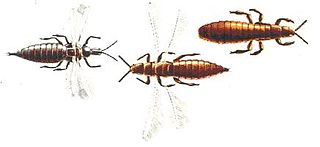
Thrips are minute, slender insects with fringed wings and unique asymmetrical mouthparts. Different thrips species feed mostly on plants by puncturing and sucking up the contents, although a few are predators. Entomologists have described approximately 6,000 species. They fly only weakly and their feathery wings are unsuitable for conventional flight; instead, thrips exploit an unusual mechanism, clap and fling, to create lift using an unsteady circulation pattern with transient vortices near the wings.

Phlaeothripidae is a family of thrips with hundreds of genera. They are the only extant family of the suborder Tubulifera, alongside the extinct family Rohrthripidae and are themselves ordered into two subfamilies, the Idolothripinae with 80 genera, and the Phlaeothripinae with almost 400. Some 3,400 species are recognised in this family, and many are fungivores living in the tropics.
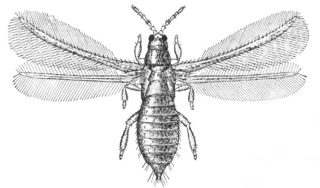
The Thripidae are the most speciose family of thrips, with over 290 genera representing just over two thousand species. They can be distinguished from other thrips by a saw-like ovipositor curving downwards, narrow wings with two veins, and antennae of six to ten antennomeres with stiletto-like forked sense cones on antennal segments III and IV.

The Aeolothripidae are a family of thrips. They are particularly common in the holarctic region, although several occur in the drier parts of the subtropics, including dozens in Australia. Adults and larvae are usually found in flowers, but they pupate on the ground. While they normally prey on other arthropods, many feed also on flowers.
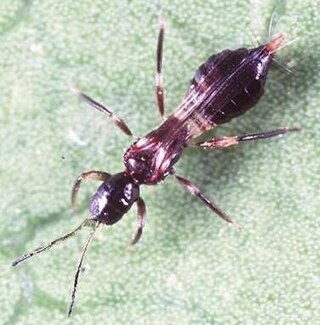
Franklinothrips is a genus of thrips with pantropical distribution.

Orthotospovirus is a genus of negative-strand RNA viruses, in the family Tospoviridae of the order Bunyavirales, which infects plants. Tospoviruses take their name from the type species tomato spotted wilt orthotospovirus (TSWV) which was discovered in Australia in 1919. The type species remained the only member of the family until the early 1990s when genetic characterisation of plant viruses became more common. There are now at least twenty species in the genus with more being discovered on a regular basis. Member viruses infect over eight hundred plant species from 82 different families.

The chilli thrips or yellow tea thrips, Scirtothrips dorsalis Hood, is an extremely successful invasive species of pest-thrips which has expanded rapidly from Asia over the last twenty years, and is gradually achieving a global distribution. It has most recently been reported in St. Vincent (2004) Florida (2005), Texas (2006), and Puerto Rico (2007). It is a pest of economic significance with a broad host range, with prominent pest reports on crops including pepper, mango, citrus, strawberry, grapes, cotton, tea, peanuts, blueberry, and roses. Chilli thrips appear to feed preferentially on new growth, and infested plants usually develop characteristic wrinkled leaves, with distinctive brown scarring along the veins of leaves, the buds of flowers, and the calyx of fruit. Feeding damage can reduce the sale value of crops produced, and in sufficient numbers, kill plants already aggravated by environmental stress. This thrips has also been implicated in the transmission of three tospoviruses, but there is some controversy over its efficiency as a vector.

Scirtothrips is a genus of thrips in the family Thripidae.

Haplothrips is a genus of Phlaeothripid thrips.
Frankliniella schultzei, the common blossom thrips or cotton thrips, is a species of thrips in the family Thripidae. It is found in many parts of the world and is an important pest insect in agriculture.
Ctenothrips is a genus of thrips in the family Thripidae. There are about 10 described species in Ctenothrips.
Elaphrothrips is a genus of tube-tailed thrips in the family Phlaeothripidae. There are at least 40 described species in Elaphrothrips.
Gynaikothrips is a genus of tube-tailed thrips in the family Phlaeothripidae. There are more than 30 described species in Gynaikothrips.
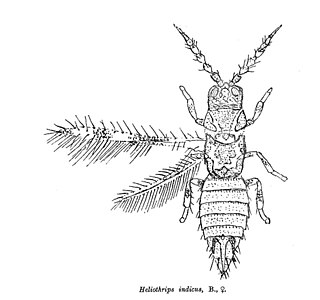
Heliothrips is a genus of thrips in the family Thripidae. There are about 18 described species in Heliothrips.
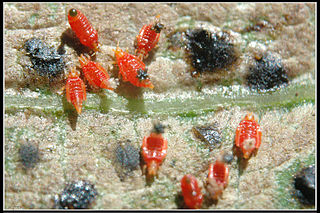
Panchaetothripinae is a subfamily of thrips in the family Thripidae. There are about 11 genera and more than 50 described species in Panchaetothripinae.
Erythrothrips is a genus of predatory thrips in the family Aeolothripidae. There are about 11 described species in Erythrothrips.

Aeolothrips is a genus of predatory thrips in the family Aeolothripidae. There are more than 80 described species in Aeolothrips.
Merothrips is a genus of thrips in the family Merothripidae. There are about 19 described species in Merothrips.
Heterothripidae is a family of thrips in the order Thysanoptera. There are about 6 genera and at least 70 described species in Heterothripidae.
Frankliniella is a genus of thrips belonging to the family Thripidae.













